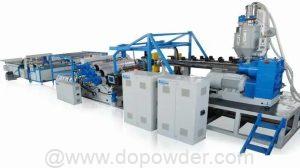What is the Production Process of Polyethylene

The production process of polyethylene can be divided into:
- High pressure method, high pressure method is used to produce low density polyethylene.
- Medium pressure
- Low pressure method. As far as the low pressure method is concerned, there are slurry method, solution method and gas phase method.
The high pressure method is used to produce low density polyethylene. This method was developed early. The polyethylene produced by this method accounts for about 2/3 of the total output of polyethylene, but with the development of production technology and catalysts, its growth rate has been significantly behind the low pressure method.
As far as the low pressure method is concerned, there are slurry method, solution method and gas phase method. The slurry method is mainly used to produce high density polyethylene, while the solution method and gas phase method can not only produce high density polyethylene, but also produce medium and low density polyethylene by adding comonomers, also known as linear low density polyethylene. vinyl. Various low-pressure processes are developing rapidly.
High Pressure Method
A method of polymerizing ethylene into low-density polyethylene using oxygen or peroxide as an initiator. Ethylene enters the reactor after secondary compression, and is polymerized into polyethylene under the pressure of 100-300 MPa, temperature of 200-300 °C and the action of an initiator. The polyethylene in the form of plastic is extruded and pelletized after adding plastic additives.
The polymerization reactors used are tubular reactors (with a tube length of up to 2000 m) and tank reactors. The single-pass conversion rate of the tubular process is 20% to 34%, and the annual production capacity of a single line is 100 kt. The single-pass conversion rate of the kettle method process is 20% to 25%, and the single-line annual production capacity is 180 kt.
Low Pressure Method
This is another production process of polyethylene , it has three types :slurry method, solution method and gas phase method. Except for the solution method, the polymerization pressure is below 2 MPa. The general steps include catalyst preparation, ethylene polymerization, polymer separation and granulation.
①Slurry method:
The resulting polyethylene was insoluble in the solvent and was in the form of a slurry. Slurry polymerization conditions are mild and easy to operate. Alkyl aluminum is often used as an activator, and hydrogen is used as a molecular weight regulator, and a tank reactor is often used. The polymer slurry from the polymerization tank is passed through the flash tank, the gas-liquid separator to the powder dryer, and then granulated. The production process also includes steps such as solvent recovery and solvent refining. Different polymerization kettles can be combined in series or in parallel to obtain products with different molecular weight distributions.
②Solution method:
The polymerization is carried out in a solvent, but both ethylene and polyethylene are dissolved in the solvent, and the reaction system is a homogeneous solution. The reaction temperature (≥140℃) and pressure (4~5MPa) are high. It is characterized by short polymerization time, high production intensity, and can produce polyethylene with high, medium and low densities, and can better control the properties of the product; however, the polymer obtained by the solution method has low molecular weight, narrow molecular weight distribution, and solid material. The content is low.
③Gas phase method:
Ethylene is polymerized in the gaseous state, generally using a fluidized bed reactor. There are two kinds of catalysts: chromium series and titanium series, which are quantitatively added into the bed from the storage tank, and the high-speed ethylene circulation is used to maintain the fluidization of the bed and eliminate the heat of polymerization. The resulting polyethylene is discharged from the bottom of the reactor. The pressure of the reactor is about 2 MPa, and the temperature is 85-100 °C.
The gas-phase method is the most important method for the production of linear low-density polyethylene. The gas-phase method eliminates the process of solvent recovery and polymer drying, and saves 15% of investment and 10% of operating cost compared with the solution method. It is 30% of the investment of the traditional high pressure method and 1/6 of the operating fee. So it has developed rapidly. However, the gas phase method needs to be further improved in terms of product quality and variety.
Medium Pressure Method
Using a chromium-based catalyst supported on silica gel, in a loop reactor, ethylene is polymerized under medium pressure to produce high-density polyethylene.
What is the Production Process of Polyethylene
